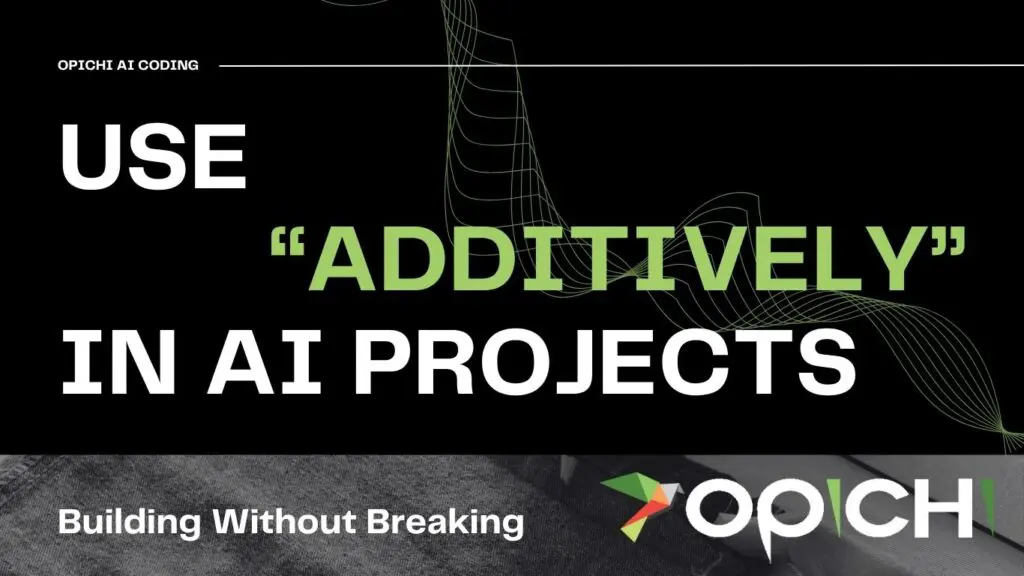Have you been weeks into building an app with an AI coding assistant, made it 80% of the way, and then every feature you told the AI to build went off the rails? Features broke. The interface is different between pages. Buttons stopped working. Chaos ensued. Your blood boils and you go onto Reddit to vent that the AI coding models are stealing your money by intentionally messing up your apps. And then someone inevitably responds: “I’Ve BuiLt 72 aPpS sTaRt To FiNiSh AnD i DoN’t HaVe ThAt PrObLeM. I CaN’t EvEn UsE uP aLl My CrEditS eVeRy MoNtH. YoU jUsT nEeD tO Be SpEciFiC.” It’s a 50/50 chance whether you’ll argue or curl up in bed to cry it out.
Let’s cut to the chase – here’s how they’re getting their entire apps built and not blowing through credits:
For every feature add, include the word “additively.”
What “Additively” Really Means
“Additively” is an efficient way to say, “Add something new without changing the old.”
In the syntax of AI it acts as a critical instruction that constrains the agent. The AI’s default behavior when asked to modify an existing block of code is often to try and rewrite the entire file to be more “optimal,” “clean,” or complete.
The problem with this default behavior is that the AI can introduce subtle bugs into working code or, worse, completely overwrite existing functions.
By using the word “additively” it’s essentially telling the AI:
“I only want the new code. Do not modify, remove, or restructure any of the existing code I’ve given you.”
How to Use in Prompts
For your own testing, toggle the coding assistant into ‘Ask’ mode for practice.
For example, when you want a feature added in a large file, include the constraint. Instead of a generic prompt like:
“In this file, please add a new function to handle user login.”
Try this instead:
“Additively, in this file, please propose the changes to add a new function called handle_login(user_id) that returns a session token.”
This narrows the scope of the AI agent’s operation and prevents it from going on an unrequested refactoring spree. This directs the AI to output only new, compatible function code.
Since it’s in ‘Ask’ mode, it won’t make changes to the existing file.
You can now review the code generated in the conversation box and then copy and paste into your existing file with minimal risk.
Why This Matters for Your Project
The additive approach is the key to safe incremental development:
It Reduces Bugs: By only changing what is necessary, this reduces the chances for introducing new bugs. By only adding one new function, if a bug appears that was not there before, the bug is almost certainly in that new function, and not in any of the ten other existing ones.
It Preserves Logic: This keeps the AI from “fixing” or “optimizing” existing application logic written for specific reasons. Remember, AI is trained on existing human-created source code. If you create something custom, the AI might not understand why; it’s only going to understand how something is “supposed” to be coded. Follow that gut feeling about when you should trust the AI coder versus when you should trust yourself.
It Saves Time: Instead of sifting through a massive rewritten file to spot the one or two new lines and check for unexpected deletions, you can copy and paste the small, isolated block of new code into the file yourself. If you don’t know where it should be pasted, ask the AI agent. Go to the line number it gives you, double-enter to move the existing code down, back up to the line, paste, and save the document.
So, the next time you’re working with an AI code helper and need to integrate a new feature, remember the magic word. “Additively” builds out your app confidently and smoothly, one feature at a time, without the stress of unexpected chaos.
Give it a try in your next AI-assisted project and see how much better your building process becomes.


